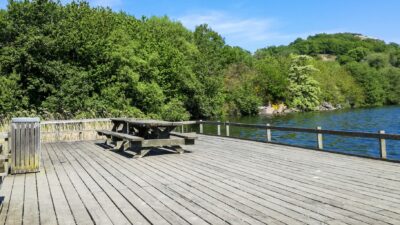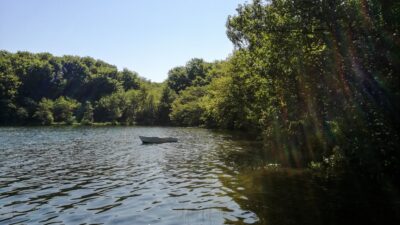Hammersøen on Nordbornholm is Denmark’s only mountain lake and the largest natural lake on the island. Hammersø is about 650 m long, 150 m wide and 13 m deep and situated about 9 m above sea level. On the two long sides it is very steep, about 2 m out the water depth is already 11 – 12 m, on the other two sides the bottom falls more evenly.
But there wasn’t always a lake here. Very far back in time, Lake Hammer was originally a sound that separated Hammerknuden from the rest of Bornholm. The lake arose because the water level in the oceans sank. Slowly, over many years, the openings to the Baltic Sea at Sæne Havn (Hammerhavnen) and Sandvig Bugten have been closed by the granite being exposed, and the lake has emerged.
Several times in history, Lake Hammer has given rise to plans to build a naval port.
In the early 1600s, under King Frederik III, the Fortress of Copenhagen was built, but during the Swedish attack in 1658, the structure was heavily damaged and an expert in fortress construction was called in. The Dutch-born fortification engineer Henrik Rüse signed a contract with the King in 1661 to fortify the fort. But he also had a plan that he wanted to see carried out. A naval base on Bornholm, in Lake Hammer. A quick survey showed that a naval port would not be impossible.
So in 1676 Bagge Wandel was sent to Bornholm to make further investigations and draw up maps before a decision was made. His measurements showed that Lake Hammer was 3.64 m above sea level towards Sandvig Bay, but as the water depth in the lake was 13 m it would have no effect on the ships when the opening was made and the water level dropped. However, the plan did not come to fruition, as there was a lot of granite under the sand between the lake and Sandvig, and it would be an almost impossible task to remove it. The naval port was instead placed on Christiansø.
But it was not the last time that a naval port was wanted in Lake Hammer. In 1716 it was Tzar Peter the Great who had plans for a naval port in Lake Hammer. His idea was that the entrance to the harbour should be from Sæne Havn and by means of locks, the ships should be raised 9 m up to Hammersøen. That plan never came to fruition either.
However, the idea of a naval port was not completely forgotten. In 1737, Count Frederik Danneskjold-Samsøe wanted to measure and draw plans for a possible harbour. This time the idea was to sail via canals and to be able to sail to the naval port from both the west (Sænebugten) and the east (Sandvig). By doing it that way, one would be able to navigate the harbor in any kind of way. Drawings for this project were done by B. Grodtschilling, and they are today in H. M. The Queen’s Reference Library. 10 drawings were made, 6 of them are preserved. But even this time no naval port came.
In 1809, during the English wars, it is again mentioned to change the Lake of Hammers into a naval port. This time it was a Commander A. Rothe. But no further action was taken.
The last time the lake is mentioned as a port is in 1889. This time, however, it was not as a naval port, but an industrial port for Hammerværket (quarry). The Lake of Hammers is seen as a possibility, but the idea is rejected and the Harbour of Sene (Hammerhavnen) is built instead.
Fortunately, Hammer Lake is still there, beautifully situated at the foot of Hammerknuden. But in your mind you might imagine an incredibly beautiful marina with various sailing boats lying at the foot of Hammer Knot.
When the lake is icy in winter, some people in the area use it as an ice rink.
Today, driving along the edge of the lake is no longer allowed. West of the lake there is a parking lot, where you can also find the old quarry lakes Opal Lake – with cable car, Crystal Lake and Siberia.


